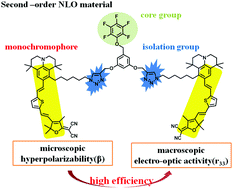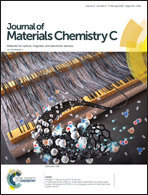A novel bichromophore based on julolidine chromophores with enhanced transferring efficiency from hyperpolarizability β to electro-optic activity
Abstract
Novel bichromophores YL3 based on julolidine donor chromophores were synthesized via a Cu(I) catalyzed click-reaction and systematically characterized in this paper. YL3 showed good thermal stability, solubility and transparency properties. Besides, the high molecular hyperpolarizability of bichromophores YL3 can be effectively translated into large electro-optic coefficients. In electro-optic activities, the doped film YL3-amorphous polycarbonate (APC) showed an electro-optic coefficient (r33) of 183 pm V−1. This value is much more than the electro-optic (EO) activity of the monochromophore (114 pm V−1) with similar structure. This result meant that the new structure of bichromophores YL3 can reduce intermolecular electrostatic interactions, thus enhancing macroscopic EO activity. These properties suggested the potential use of the new bichromophores in nonlinear optical materials.



 Please wait while we load your content...
Please wait while we load your content...